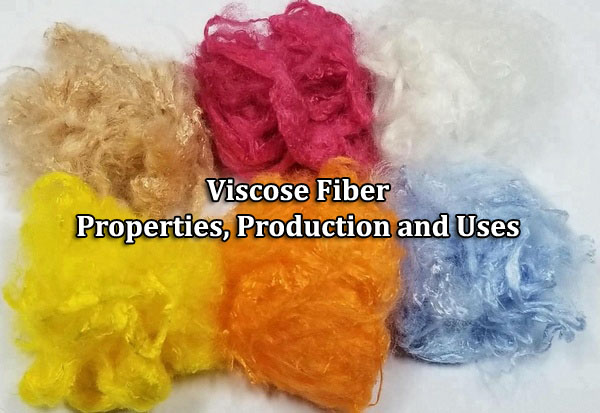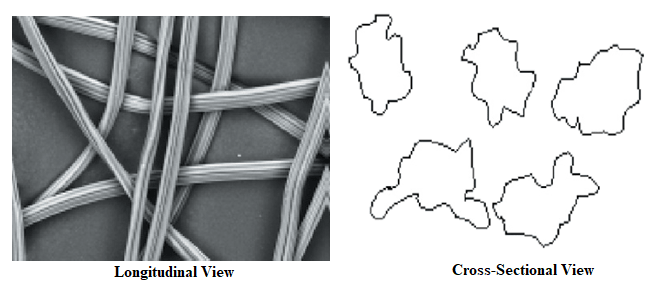What is Viscose Fiber?
Rayon was the first artificial regenerated fiber introduced in the early 19th century. Then started exploration of other fibers with natural raw materials as base, they were named as Regenerated Fibers. This versatile manmade fiber was baptized rayon at quite a later stage. For more than 35 years after it was born, it was known by various names such as artificial silk, art-silk, gloss, wood silk and fiber silk. There are three principal varieties of rayon namely viscose, cuprammonium and acetate rayon.

Viscose (or viscose rayon) is a man-made fiber composed of 100% regenerated cellulose discovered in 1891 and first commercial production was undertaken in 1905 by Courtaulds. It is made from cotton linters or wood pulp, usually obtained from spruce and pine trees. Viscose rayon is the modern form of one of the earliest types of artificial silk.
The name viscose was derived from the word viscous referring to the sticky spinning solution. The name rayon has already been referred to as a generic term desired to replace the word artificial silk. It is the most versatile and the most widely used manmade fiber. It is the cheapest because it is made from cellulose extracted from wood pulp, a cheap and widely available raw material produced in areas unsuitable for food production. It is produced in a wide range of filament thickness ranging from the fineness of natural silk to the thickness of coarse wool or hair.

Viscose rayon is weak, with high elongation at break and a low modulus. It loses 30 to 50% of its strength when wet, and needs careful laundering. It also shrinks appreciably from washing. Viscose rayon is one of the most absorbent of all textiles. It is more absorbent than cotton or linen and is exceeded in absorbency only by wool and silk. A variation of rayon is classified as high wet modulus (HWM) rayon or polynosic rayon. This type of rayon is launderable.
Properties of Viscose Fiber:
1. Absorbency:
Viscose is one of the most absorbent fibers; it is even more absorbent than cotton or linen. However, it loses 40%—70% of its strength when it becomes wet. As it absorbs well it has a high affinity for dyes, including direct, acid and disperse dyes.
2. Drape:
It has good draping qualities due to the heaviness of the fibers.
3. Conductivity:
Viscose has a high rate of conductivity, which means it remains cool in warm temperatures. Spun rayon can be napped to trap air making it suitable to wear for colder months.
4. Strength:
Viscose is fairly strong, especially if it is made from multifilament yarns. However, care must be taken when the material becomes wet because it will become weaker.
5. Resistance:
Viscose has good resistance to sunlight, especially colored viscose which withstands strong sunlight better than silk. However, white viscose, when exposed to prolonged sunlight, will yellow and deteriorate the fabric. Viscose is fairly resistant to perspiration, but the color may fade, and to household bleaches.
6. Susceptible:
Viscose has some elasticity but it creases readily. Variants to the yarn and fabric structure make it less likely to crease e.g. fine, multifilament yarns and crêpe weave with tightly twisted yarns. As viscose is a cellulose-based fiber it shrinks; in fact, it shrinks even more than cotton, especially crêpe weaves and knitted fabrics. Spun viscose also shrinks more than filament fabrics. Viscose burns very easily, especially when it is a napped fabric that has trapped some air. It is affected by mildew if kept in damp conditions. Concentrated alkalis disintegrate fabrics, so one should use mild soap and lukewarm water when laundering viscose. Hot and dilute acids or cold and concentrated acids also disintegrate viscose.
7. Sustainability:
It can be said viscose is sustainable in that it is produced from wood pulp. However, the production process uses harmful chemicals and the waste products have to be disposed of carefully and, therefore, not considered environmentally friendly. Lyocell is a forerunner of regenerated cellulosics because it recycles chemicals within the production process.
Production Process of Viscose Fiber:
Wood pulp from spruce, hemlock, or pine trees is soaked in caustic.
↓
The mixture is flattened to remove excess chemicals, which produces sheets of alkali cellulose. The sheets look similar to pieces of blotting paper.
↓
The sheets are aged for two to three days (while being kept at constant temperature and humidity levels).
↓
The cellulose alkali is churned with liquid carbon disulphide to transform it into cellulose xanthate, which is light orange in color.
↓
The crumbs are dissolved in a weak solution of caustic soda. The mixture is thick, viscous, and golden at this stage, which makes it look a lot like honey. Now known as Viscose.
↓
The solution is filtered to remove all impurities.
↓
The solution is then left to mature for approximately three months.
↓
The material is vacuum treated in order to remove excess bubbles created during the maturation process. This process prevents the filaments from breaking upon extrusion.
↓
Wet Spun: the polymer is extruded through a spinneret (in a coagulating bath).
↓
It is then stretched to straighten and flatten the molecules to increase the material’s strength and cohesion.
↓
At the same time as extrusion the coagulating bath of sulphuric acid sets cellulose in the fibers.
↓
Staple lengths are created ←←←←←→→→→→Continuous filament is created
Finishes of Viscose Rayon:
- Flame Retardant finishes are possible, especially on napped fabrics.
- Napping on spun viscose brings the short fibers to the surface to make the fabric feel softer and/or warmer.
- Calendering provides a smooth finish or embosses a pattern.
- Shrink Resist adds greater stability.
- Water Resist when the end use requires it. This process strengthens the fabric.
- Crease Resistance improves shape retention; otherwise the fabrics have poor resilience.
Variations of Viscose Rayon:
1. Hollow Fiber:
When sodium carbonate is added to the viscose solution carbon dioxide forms inside the fiber in the coagulating bath, which forms an oval hollow inside the fiber. This feature provides loft, additional bulk and absorbency. It is known as high-absorbency viscose used in sanitary wear.
2. Ribbon/Straw:
Produces a flat, cross-sectioned fiber for textured fabric (a bit like woven straw).
3. Crimped/Looped:
Changes to the coagulating bath can cause latent crimp; the fibers or yarn crimp when it is submersed in cold water during a later production process.
4. Delustre:
Varies from bright to semi-dull to dull depending upon the amount of delustre agent placed in the vat before extrusion.
5. High-Tenacity:
A thicker skin and tighter alignment of the molecules via high extension or stretch produces high tenacity. This variation is used for car tyres.
6. Dyes:
Can be added to the polymer solution to imbue the material with permanent color.
Viscose Fabrics:
A large proportion of man-made fabrics on the market today are sold with just the fiber content. However, there are a few fabrics that are either 100% or some percentage of viscose.
Butcher rayon or linen, challis, crêpe, éponge, frieze or frise, gamsa, gauze, jersey, lawn, mozambique, shirting, slub and winceyette.
Uses of Viscose Fiber:
A wide variety of clothing, including dresses, blouses, tops and trousers. It is blended with other fibers, e.g. wool, to reduce the cost of the fabric. It is also used for soft furnishings, including curtains, cushions, tablecloths and serviettes. It has a great benefit to the non-woven industry because it is cheap to produce and useful for disposable products such as nappies, kitchen cloths, sanitary wear, sportswear and medical swabs.
References:
- Fibres to Fabrics by Bev Ashford
- The Substrates – Fibres, Yarn and Fabric by Mathews Kolanjikombil
- Introduction to Textile Fibres by H. V. Sreenivasa Murthy
- https://textilelearner.net/rayon-fiber-types-properties/
You may also like:
- Sisal Fiber: Properties, Production Process and Uses
- Properties, Processing and Uses of Kenaf Fiber
- Milkweed Fiber: Properties, Processing and Applications
- Kapok Fiber: Properties, Processing and Applications
- Hemp Fiber: Properties, Processing and Uses
- Properties, Extraction and Uses of Pineapple Leaf Fiber
